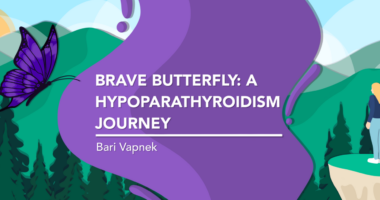
Hypoparathyroidism diagnosis
Last updated May 30, 2025, by Marisa Wexler, MS

Hypoparathyroidism is a rare disorder marked by abnormally low levels of parathyroid hormone (PTH), a signaling molecule that helps regulate calcium and phosphorus in the body.
The condition is usually diagnosed through blood tests that measure PTH levels, alongside calcium and phosphorus. But other tests may be used to confirm the diagnosis and check for more serious complications of the disease.
An early diagnosis of hypoparathyroidism is important to ensure prompt treatment and minimize the risk of long-term complications.
How is hypoparathyroidism diagnosed?
The diagnostic process of hypoparathyroidism typically begins with a physical examination, where doctors check for common hypoparathyroidism symptoms such as muscle cramps, abnormal sensations, or spasms.
A detailed review of a person’s medical and family history is also normally gathered to help identify potential hypoparathyroidism causes, such as recent neck surgery or a family history of genetic conditions associated with parathyroid dysfunction.
If hypoparathyroidism is suspected based on symptoms and history, lab tests are usually ordered to confirm a diagnosis.
Blood tests
Blood tests to measure levels of calcium and PTH are the main tools to establish a hypoparathyroidism diagnosis. According to current diagnostic criteria, a diagnosis can be confirmed if someone has low serum calcium test levels and low or inappropriately normal PTH levels on two separate occasions at least two weeks apart.
If hypoparathyroidism tests consistently show low calcium or PTH levels over time, the condition is considered chronic hypoparathyroidism. Both six months and one year have been proposed as a minimum duration for establishing a diagnosis of chronic hypoparathyroidism.
Blood tests may also be used to detect elevated phosphorus levels, another sign that supports a diagnosis of hypoparathyroidism, and rule out other potential causes of abnormal calcium levels.
Urine tests
PTH acts on the kidneys to prevent calcium from being excreted in the urine. In hypoparathyroidism, the lack of PTH leads to too much calcium being secreted into the urine. As such, urine tests revealing elevated calcium levels can help support a hypoparathyroidism diagnosis.
These tests are also used to monitor creatinine levels and other markers of kidney function toward kidney health. Because hypoparathyroidism can cause kidney problems, regular monitoring their function is recommended for people with the disease.
Imaging tests
Imaging tests are not required to establish a diagnosis of hypoparathyroidism, but they may be used to assess how the disease is affecting the body. Imaging tests to monitor hypoparathyroidism symptoms and complications may include:
- a CT scan or MRI to detect calcium deposits in the brain or changes in brain structure
- a CT scan or ultrasound to evaluate the kidneys for problems such as kidney stones or calcium deposits.
Genetic testing
Some types of hypoparathyroidism are caused by inherited genetic mutations. When a genetic cause is suspected, testing may be used to help confirm the diagnosis. This is usually done on a blood sample and looks for mutations in genes known to be associated with hypoparathyroidism.
Bone density scans (DEXA)
Dual-energy X-ray absorptiometry (often abbreviated DXA or DEXA) is a scan to measure the mineral density of bones. Because hypoparathyroidism can affect bone metabolism, DEXA scans may be used to monitor for bone problems, particularly in older patients.
Electrocardiogram (EKG)
An electrocardiogram (also known as ECG or EKG) is a test that tracks how the heart is beating. Because low calcium levels in hypoparathyroidism can lead to abnormal heart rhythms (arrhythmias), an EKG may detect these issues and monitor heart health.

Importance of an early diagnosis
If left untreated, hypoparathyroidism can lead to a range of serious health problems. Some of these, including cataracts, calcium deposits in the brain, and dental issues, cannot be reversed even when the underlying hypoparathyroidism is treated.
An early hypoparathyroidism diagnosis allows patients to start treatment as soon as possible, which can help prevent such complications from developing in the first place. A prompt diagnosis and appropriate treatment can also lower the risk of life-threatening complications such as seizures or difficulty breathing.
With early diagnosis and treatment, the prognosis for people with hypoparathyroidism is generally good, and hypoparathyroidism life expectancy is typically similar to that of the general population.
Diagnostic challenges
Many people with hypoparathyroidism have mild or unspecific symptoms that may not be immediately recognized as symptoms of the disease. It is not uncommon for hypoparathyroidism to be diagnosed incidentally, through routine lab tests that detect low calcium and PTH levels in people who otherwise appear healthy.
When performing the diagnostic workup, it’s often necessary to consider a hypoparathyroidism differential diagnosis, that is, the process of ruling out other conditions that may cause similar symptoms, particularly low calcium levels (hypocalcemia). Other possible causes include very low magnesium levels, which can impair PTH secretion, and PTH resistance, where the body does not adequately respond to PTH.
A hypocalcemia diagnosis in someone with known risk factors for hypoparathyroidism, such as a recent neck surgery or a relevant family history, may be sufficient to suspect the disease, but measuring PTH levels is necessary to confirm a hypoparathyroidism diagnosis.
Next steps following a diagnosis
After a diagnosis of hypoparathyroidism, patients should work with their healthcare team to develop a personalized treatment and care plan. Management usually involves calcium and vitamin D supplements to maintain normal calcium levels, which are generally needed for life. Other treatments, including certain diuretics to reduce calcium loss in urine and medicines that work to replace PTH, also may be used to manage hypoparathyroidism.
Another important aspect of long-term hypoparathyroidism care is routine monitoring to detect and treat any health complications as soon as they emerge. Patients and their care team will work together to create a monitoring schedule that makes sense for their specific situation.
Hypoparathyroidism News is strictly a news and information website about the disease. It does not provide medical advice, diagnosis, or treatment. This content is not intended to be a substitute for professional medical advice, diagnosis, or treatment. Always seek the advice of your physician or other qualified health provider with any questions you may have regarding a medical condition. Never disregard professional medical advice or delay in seeking it because of something you have read on this website.
Recent Posts
- New 5-tier system aims to better guide hypoparathyroidism treatment
- Reflections on gratitude and hope for the new year
- Rethinking my holiday plans with hypopara limitations in mind
- Hypopara’s unpredictability causes surprises during treatment
- Online tool predicts who’s at risk for chronic complication after surgery


